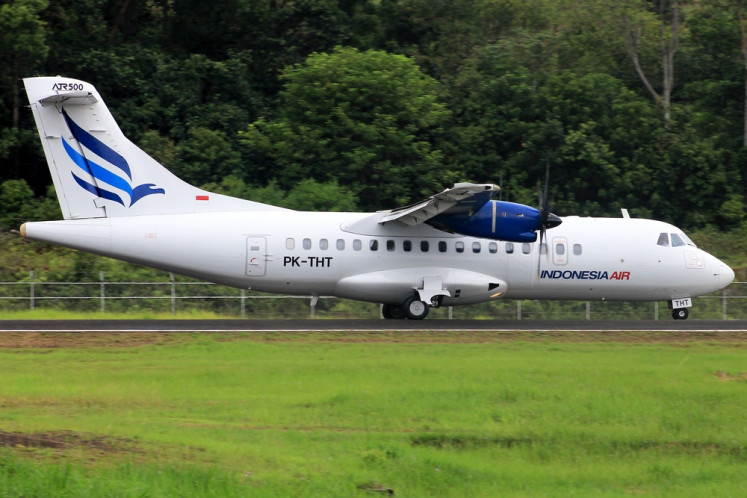Popular Reads
Top Results
Can't find what you're looking for?
View all search resultsPopular Reads
Top Results
Can't find what you're looking for?
View all search resultsAccelerate production to stop decline
Upstream oil and gas regulator BPMigas is currently under the spotlight for Indonesia’s declining oil production
Change text size
Gift Premium Articles
to Anyone
U
pstream oil and gas regulator BPMigas is currently under the spotlight for Indonesia’s declining oil production.
As of Feb. 28, the country’s total output was only 885,000 barrels per day (bpd), far lower than the target of 950,000 bpd.
BPMigas head Raden Priyono talked with The Jakarta Post’s Rangga D. Fadillah about the agency’s strategies for ramping up oil production this year and its efforts to minimize disruption in upstream oil and gas activities. Below are the excerpts:
Question: Indonesia is experiencing a drop in oil production. What strategies have been prepared by BPMigas to encourage contractors to ramp up production?
Answer: The natural production decline for oil in Indonesia stands at around 12 percent. To hold the decline rate at that level, we encourage contractors to utilize the put-on production (acceleration of production) scheme, apply enhanced oil-recovery (EOR) technologies and we have accelerated the approval of the plans of development (PoD) for new fields. In 2011, EOR activities contributed a total production of 333,994 barrels of oil per day (bpd) or around 40 percent of the country’s total oil output. Through those activities, we can cut the natural-decline rate from 12 percent to only 3 percent.
In addition to these strategies, we also encourage exploration to discover new reserves so that, hopefully in the future, we can produce more oil. Our exploration has shown positive progress. Last year, our reserve-replacement ratio (RRR) jumped to 61 percent from only 41 percent in 2010. It means that for every one barrel we exploit, we discover 0.61 barrel as a replacement. Ideally, RRR should be 1:1, but several non-technical problems in the field have made it difficult for us to realize that figure.
Our efforts to discover new oil and gas reserves have now shifted to the eastern part of the country and to deep water areas that pose more risks for contractors, what are the challenges in developing those areas? Have any incentives been offered?
It is true that following the decline of reserves onshore, we are now intensifying exploration in eastern Indonesia and in deep-water areas. We are no longer talking about waters with a depth of between 500 and 1,000 meters, but deeper than that, like the development of the Abadi field at the Masela block in the Arafura Sea, Chevron’s Indonesia Deepwater Development (IDD) in the Makassar Strait and Eni Spa’s Jangkrik field at the Muara Bakau block.
We provide incentives in the form of the acceleration of the PoD-making process. In the Jangkrik field for instance, the PoD approval only took 15 days. That was the fastest PoD in BPMigas history. Commercial incentives can be given as a last resort if the development of a block does not meet the economic scale of the contractor. We are committed to accelerating the PoD-making process for potential fields predominantly in eastern Indonesia and deep-water areas.
Regional governments often issue regulations that are counter-productive for upstream oil and gas activities as in Cepu, East Java. How does BPMigas address this problem?
The problem in Cepu (where the regional government issued a regulation obliging ExxonMobil to build offices in areas outside the block and awarded some work to local companies) has been settled. President Susilo Bambang Yudhoyono has also issued a presidential instruction to help the country reach its oil-production target of 1.01 million bpd in 2014. All governors, regents and mayors across the country have to follow the instruction.
The enactment of the 2012 Law on Land Procurement is also expected to minimize problems faced by oil and gas contractors in boosting production in their working areas.
Last year, 51 percent of the total disruption in upstream activities was external, for example social problems, security disturbances, difficulties in obtaining permits from regional governments and overlapping lands. Through the instruction, President Yudhoyono ordered all governors, regents and mayors to accelerate permit issuance.
How about the plan to develop unconventional gas?
Our unconventional gas reserves are even larger than the conventional ones. For 2012, our conventional gas reserves stand at 104.49 trillion cubic feet [tcf]. For unconventional gas, coal bed methane [CBM] for example, the potential reserves are 454.3 tcf in 11 basins across the country. Investors’ interest in developing CBM is very high. As of 2011, there were 42 CBM contractors working under the coordination of BPMigas. We are committed to continuously supporting the development of CBM, in the future CBM could be converted into liquefied natural gas [LNG].
In the US, the development of shale gas is a success story; it has brought down gas prices there to between $2 and $3 per million British thermal units (BTU). Will it influence Indonesia’s LNG sales?
What is happening in the US currently is similar to when Indonesia tried to sell LNG from the Tangguh LNG plant in Papua between 2000 and 2005, where supply exceeded demand so that the price fell dramatically. The US has developed shale gas on a massive scale since 2000, but in 2008, an economic crisis hit the country, leading to a drop in energy demand, including for natural gas.
As of today, the US government has not shown an interest in exporting LNG on a large scale because with its economic recovery, the demand for gas is expected to surge gradually and the price will be corrected to between $4 and $5 per million BTU to maintain the sustainability of shale gas development for the future.
I think Indonesia can benefit from this situation because with the growing supply of gas in the US, we can divert the LNG from Tangguh that is allocated for US-based Sempra Energy. Sempra already fulfills its gas need from the US domestic market. We hope we can divert around 90 percent of Sempra’s total gas allocation [3.7 million tons a year].










